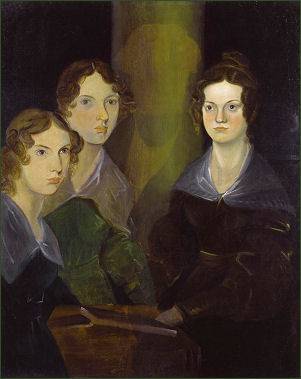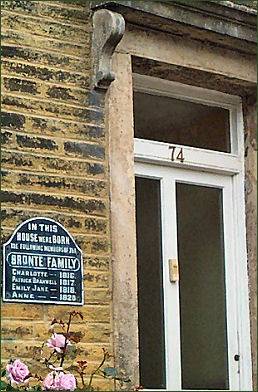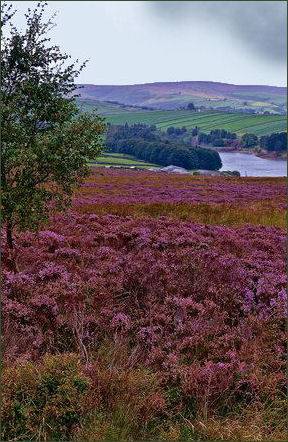Bronte Country
OS grid reference:- SD 998 357
 The area which is known as Bronte Country includes the Pennine hills to the west of the Bradford- Leeds conurbation, Kirklees and Calderdale. The bleak and often evocative landscape of of the region inspired the Bronte sisters, Charlotte, Emily and Anne, to write the classic novels which made them famous.
The area which is known as Bronte Country includes the Pennine hills to the west of the Bradford- Leeds conurbation, Kirklees and Calderdale. The bleak and often evocative landscape of of the region inspired the Bronte sisters, Charlotte, Emily and Anne, to write the classic novels which made them famous.
 Charlotte (1816-1855), Emily (1818-1848) and Anne Bronte (1820-1849), along with their brother Patrick Branwell (1817-1848) where born in a house on Market Street (pictured right) in the village of Thornton on the outskirts of Bradford. Their father, the Reverend Patrick Bronte, a native of Loughbrickland, County Down, was curate at the Old Bell Chapel in Thornton.
Charlotte (1816-1855), Emily (1818-1848) and Anne Bronte (1820-1849), along with their brother Patrick Branwell (1817-1848) where born in a house on Market Street (pictured right) in the village of Thornton on the outskirts of Bradford. Their father, the Reverend Patrick Bronte, a native of Loughbrickland, County Down, was curate at the Old Bell Chapel in Thornton.
Patrick Bronte accepted the perpetual curacy of Haworth in 1820, when the family moved into the Bronte Parsonage. The Georgian parsonage is now a museum to Britain's greatest literary family. The house contains period rooms containing original furnishings, and displays, paintings, books and manuscripts belonging to the Bronte family.
Just the year after moving into the Parsonage at Haworth, on 15 September 1821, Maria Bronte died of uterine cancer. Her sister, the spinster Elizabeth Branwell, came from Penzance to help Patrick look after the children and to take over the running of the Bronte household. The sisters were educated at the Clergy Daughters' School at Cowan Bridge, near Kirkby Lonsdale. Their elder sisters Maria (born 1813 or 14) and Elizabeth (1815) tragically died of tuberculosis at the parsonage in 1825.
Patrick Bronte was a conscientious priest, carrying out his duties as well as directing the National and Sunday Schools. Patrick's Sunday School is still standing today The Old School Room, where Charlotte, Emily, Anne and Branwell all taught and its attached cottage lies within the precinct of Haworth Church.
Their brother Branwell, a painter and writer, was addicted to alcohol and opium, he developed tuberculosis and died suddenly on Sunday 24 September 1848, aged 31. Emily was also dying from tuberculosis, never left the house after Branwell's funeral. She died aged of 30 on 19 December 1848. Anne too had tuberculosis. She was taken to Scarborough to try a sea cure but died four days after arriving there on 28 May 1849, aged 29 years.
Arthur Bell Nicholls arrived in Haworth in 1845 to serve as a curate, due to Patrick Bronte's failing eyesight, he soon took over most of the church duties. The only surviving sister, Charlotte, married Arthur Bell Nicholls in Haworth Church on 29 June 1854. She died on 31 March 1855, in the early stages of pregnancy, three weeks before her 39th birthday. Charlotte was interred in the family vault in the Church of St Michael and All Angels at Haworth. Patrick Brontė lived on at the parsonage for six more years, cared for by his son-in-law, and died there on 7 June 1861, at the age of 84.
 The Bronte Waterfalls consist of a series of small stepped falls on South Dean Beck over layers of grit stone. The falls were described by Charlotte Brontė as "fine indeed; a perfect torrent racing over the
rocks, white and beautiful". Below the falls stands an old stone bridge known as Brontė Bridge which crosses the beck. A stone at the waterfalls known locally as the Bronte chair.
The Bronte Waterfalls consist of a series of small stepped falls on South Dean Beck over layers of grit stone. The falls were described by Charlotte Brontė as "fine indeed; a perfect torrent racing over the
rocks, white and beautiful". Below the falls stands an old stone bridge known as Brontė Bridge which crosses the beck. A stone at the waterfalls known locally as the Bronte chair.
A nature trail known as the Brontė Trail starts from Haworth and crosses the moors to the waterfall, the moorland on the way to the falls is famous for the birds that breed there, including curlews, golden plover peregrines and merlins. It continues to Top Withens, an abandoned farmouse on the moors which is said to be the inspiration for the Earnshaw home in Emily Bronte's classic masterpiece 'Wuthering Heights', a tale of love and revenge on the Yorkshire moors.
Ponden Hall, a farmhouse near Stanbury is reputed to be the inspiration for the Thrushcross Grange of 'Wuthering Heights' and Oakwell Hall and were Fieldhead and Briarmains in Charlotte Bronte's novel 'Shirley'. Red House is now a museum which includes period rooms, recreated gardens and exhibitions in restored outbuildings.
Oakwell Hall, an Elizabethan manor house in the village of Birstall and Red House an 1830's cloth merchants's home in Gomersal, which Charlotte Bronte visited frequently, were Fieldhead and Briarmains in Shirley, Charlotte Bronte was also a regular visitor to Gawthorpe Hall near Burnley.
Nearby Wycoller Hall (pictured left) in the village of Wycoller, stands just across the border in Lancashire, it is thought to be the inspiration for Ferndean Manor (the home of Mr. Rochester) in Charlotte Bronte's novel 'Jane Eyre'.
Both Charlotte and Emily probably visited Wycoller on their walks. Parallels have been drawn with the owner of Ferndean, Mr Rochester's father, and Henry Owen Cunliffe, the squire of Wycoller. One of the hall's occupants, Elizabeth Cunliffe, also became Elizabeth Eyre by marriage. Wycoller Hall was even used to illustrate the cover of the 1898 edition of Jane Eyre. The delightful main street of Wycoller is lined with characterful period stone buildings. Visitors can access the village via a short walk from the nearby car park.
The school at Cowan Bridge, near Ingleton provided the inspiration for Lowood School in 'Jane Eyre', while the late medieval manor house of Norton Conyers at Wath near Ripon, which Charlotte Bronte visited in 1839 is thought to be the setting for Thornfield Hall in the novel. The legend of a mad woman confined in the attic in the previous century is said to have given her the idea for the mad Mrs Rochester in 'Jane Eyre', and the house's interior gave her many ideas for Mr. Rochester's 'Thornfield Hall'.
The Bronte Way, a 69km (43 mile) long distance footpath which starts at Oakwell Hall and ends at Gawthorpe Hall in Padiham, passes through Wycoller, leading to the Bronte sisters' home in Haworth.
